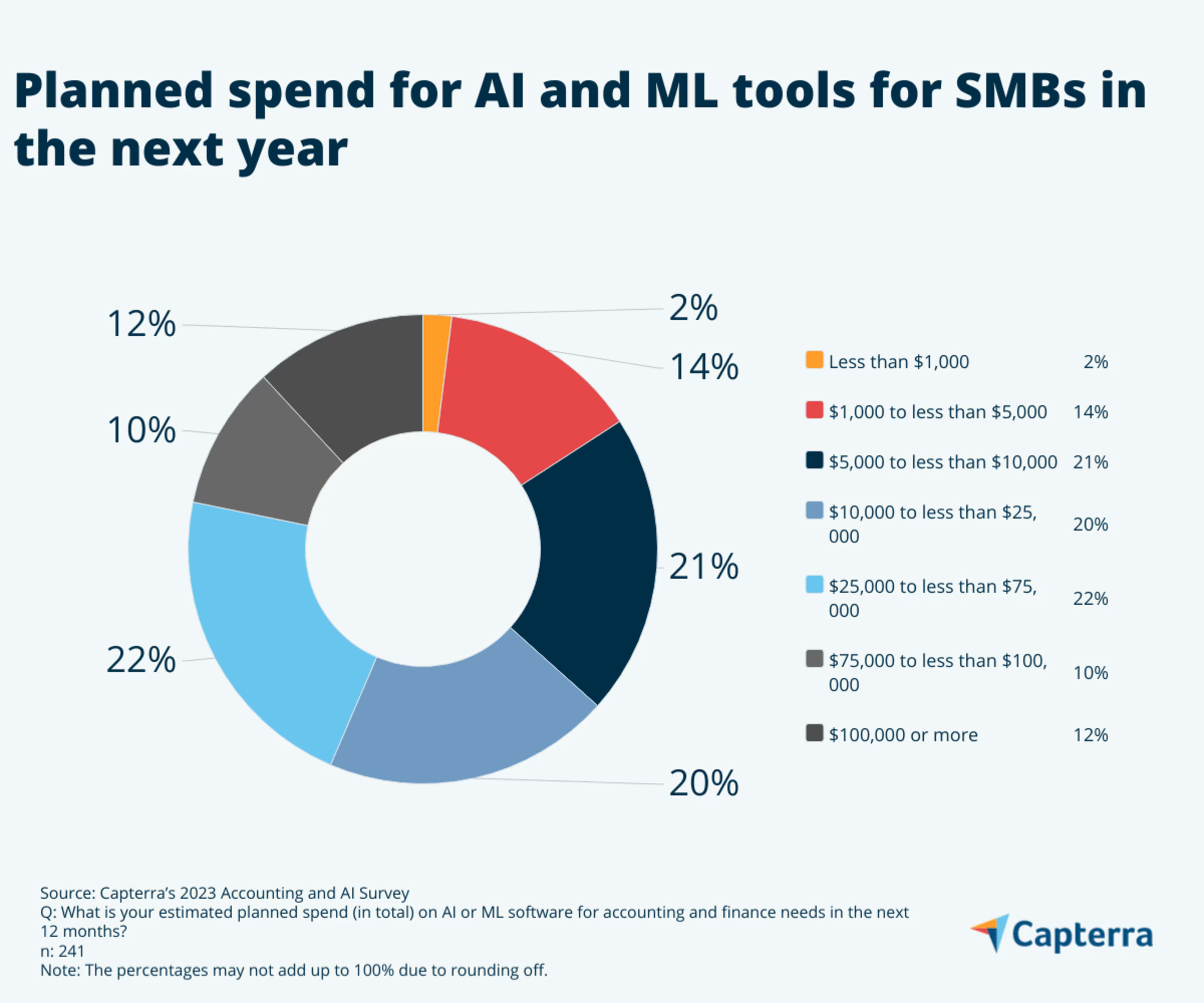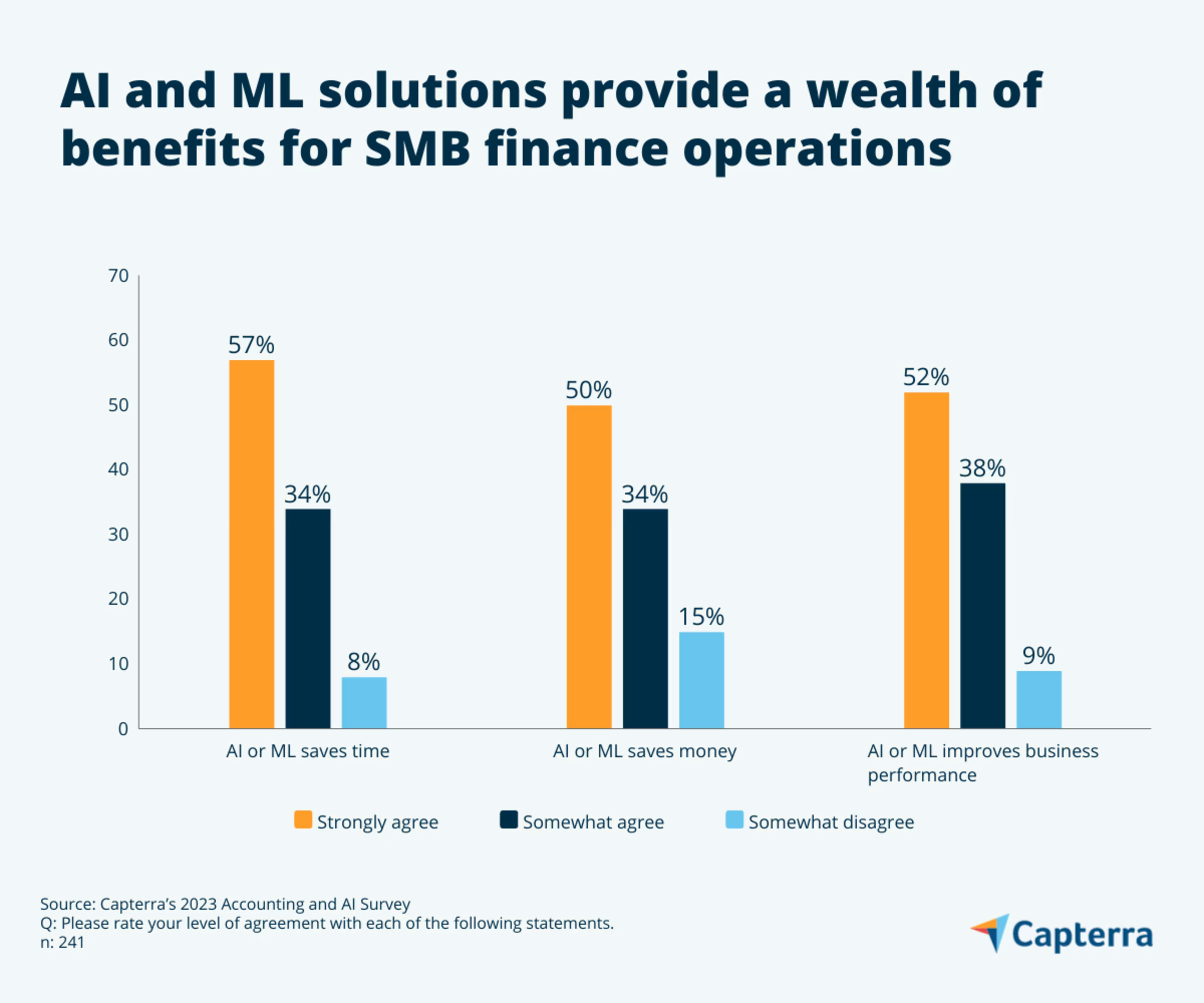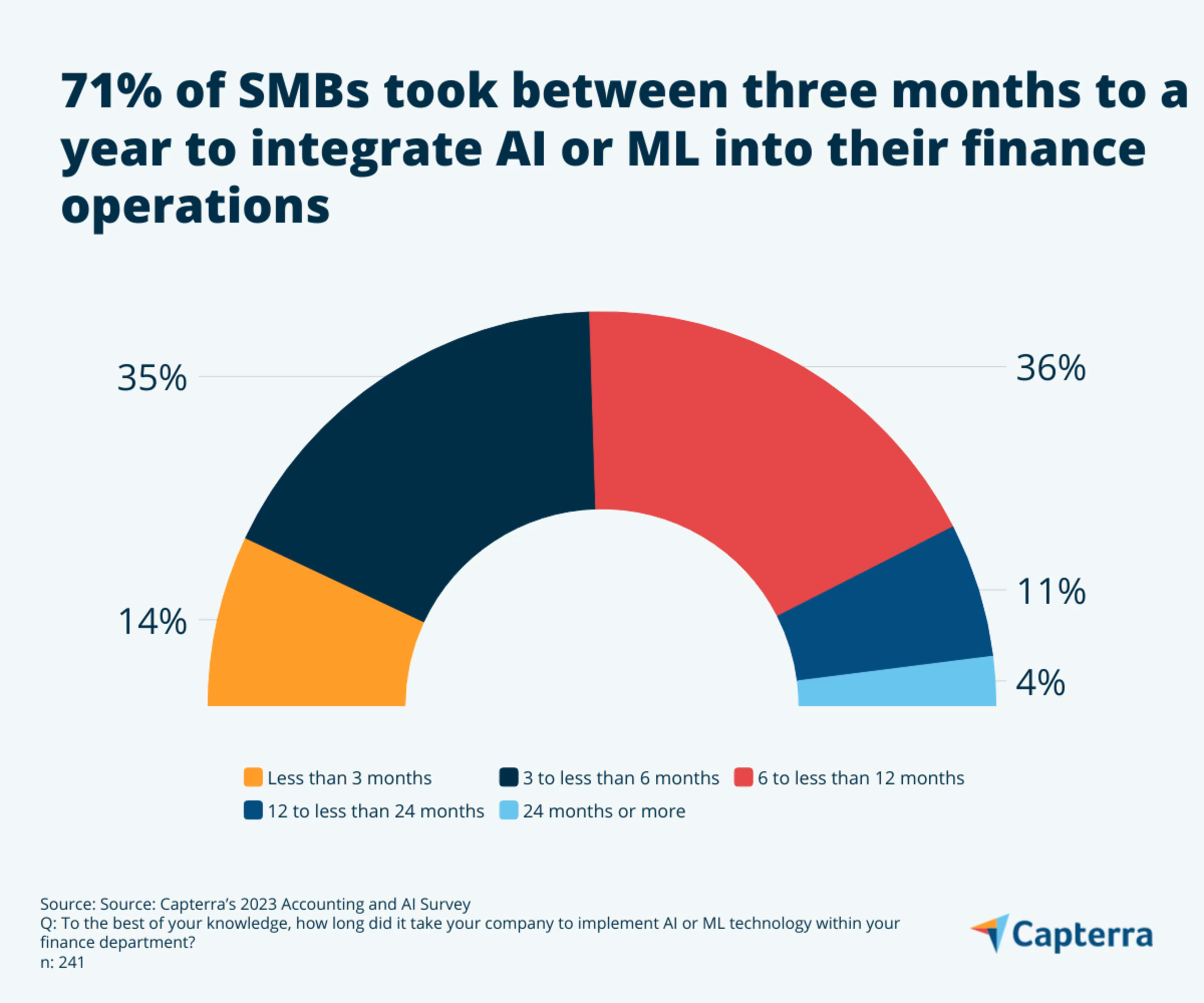Only 15% of businesses report negative ROI when using artificial intelligence or machine learning software in finance operations.
Artificial intelligence (AI) and machine learning (ML) technologies have rapidly advanced in the last few years, offering small and midsize businesses (SMBs) new ways to augment and streamline their finance operations as the software becomes more accessible and affordable.
In fact, according to Capterra's 2023 Accounting and AI Survey of 317 business leaders, 51% of SMBs say AI and ML will fundamentally change business finance operations for the foreseeable future, and 76% of businesses have adopted at least one form of AI or ML technology to handle accounting and finance needs.*
However, compared to their larger competitors, SMBs face unique challenges when adopting and implementing AI and ML solutions. They don't have as much money, time, and manpower to dedicate to developing these technologies within their finance department.
If you're considering investing in these technologies, it can be difficult to decide where it best fits in within your organization—AI software and ML software can assist with everything from bookkeeping to fraud detection—and you might be concerned about how long it takes to implement these solutions and if they generate favorable return on investment (ROI).
By exploring how other SMBs are using AI and ML, this report can help address common concerns, while also providing insight into how much businesses plan to spend on these solutions, whether they tap into free or paid software to meet their goals, and more.
/ Key findings
A majority of businesses (76%) harness AI or ML for financial tasks.
80% of SMBs report experiencing positive ROI when using AI or ML software in finance operations.
57% of businesses say AI or ML is very effective when it comes to accomplishing accounting objectives, and more than half strongly agree that the technology helps them save time and money, improves businesses performance, and gives them a competitive edge.
Businesses say that they use AI or ML to handle approximately 62% of their accounting and finance needs.
Most businesses use paid versions of AI or ML software (44%) as opposed to free tools (17%) to handle financial tasks, including payroll management, expense management, and bank reconciliation.
What are AI and ML technologies and how do they work in finance?
AI and ML technologies are computer systems that can mimic human intelligence using math and logic to simulate how people digest information and make decisions—ML is a subset of AI that, without direct instruction, enables computers to learn and improve on their own based on past data and experience. Though AI and ML are connected, they are often conflated, as both technologies use statistical algorithms to analyze financial data to generate insights and identify patterns. These technologies can also be used to efficiently automate tasks like data entry using algorithms and much more.
Paid tools can be pricey, but SMBs are ready to foot the bill
The power of AI and ML cannot be underestimated, as it's being used for everything from detecting early stages of cancer to revolutionizing online customer support. The application of this tech isn’t lost on finance and accounting teams—only 5% of SMBs say that they have not and do not plan to adopt AI or ML software to handle any accounting and finance tasks.
In fact, SMBs are investing heavily in AI and ML—44% of respondents have already invested between 11% and 40% of their overall IT budget on AI or ML software, and only 5% of organizations have earmarked less than $5,000 toward these types of software in the future.

Even though most SMBs have set aside a good chunk of cash toward AI and ML investments and initiatives, 33% of respondents note that the cost of or obtaining funding for these technologies is one of the top challenges they face when proving ROI. Custom AI and ML solutions can run businesses from $6,000 to $300,000 per solution, and, on average, third-party software can cost up to $40,000 per year.[1]
SMBs gravitate toward using paid (44%) rather than free (17%) versions of AI or ML software, likely because paid solutions include more advanced features—like predictive analytics—and come packaged with more opportunities for customization and tools. Paid software also comes with more dedicated support and security features that are more robust than free alternatives.
/ Our recommendation
AI-as-a-Service (AIaaS) can enable SMBs to work with third-party AI and ML service providers at a lower initial cost and commitment than what in-house development usually requires. AIaaS providers can quickly and easily handle software design, deployment, management, and more. If you're interested in AIaaS, check out our hiring guides for AI services and ML services as a starting point for your search.
As benefits blossom, worries about ROI become a thing of the past
Every business that has implemented AI and ML within their finance operations has had to navigate the challenge of return on investment (ROI). SMBs report that some of the most pressing challenges with these solutions include difficulties assessing and monitoring the technology's performance, fear of increased errors in financial content, and a company's values or culture clashing with the idea of AI and ML implementation.
Even with these concerns, 80% of SMBs that already use AI and ML say their company has experienced positive ROI when using the software in financial operations; further, more than half of SMBs strongly agree that the technology has helped them save money and time, as well granting their company a competitive edge.
Automated financial reporting and chatbots have been estimated to save businesses an average of nearly 40 hours a week, and can potentially save organizations ~$35,000 every year.[2]

Beyond cost and time savings, SMBs say the technology has a range of data-related benefits which include better creation and visualization of financial data, improved data management, and enhanced insights into trends and audience preferences. For instance, ML algorithms can be used to identify patterns in spending and generate ways to optimize purchasing or budgeting decisions. Our data also found that—compared to only 2% of businesses who strongly disagree—46% of SMBs strongly agree that financial reports and content generated by AI and ML are just as good if not better than human-generated content.
/ Our recommendation
Proving ROI is easier said than done. One way to help make the case for AI and ML being profitable investments starts with defining your business needs and funding, which the process of financial planning streamlines. By mapping out other important aspects of these initiatives, such as data strategy so that your AI and ML algorithms have more to work from, you can help choose the right technology for your business. Additionally, you can also run a proof of concept to test solutions before scaling, so that any corrections before a full launch can be amended.
Practical processes are the best suited for AI and ML
Finance has been a ripe field for the application of AI and ML. Researchers are just beginning to explore how ChatGPT can potentially analyze headlines based on sentiment to make stock market predictions, and some preprints are delving into harnessing related technology to understand what regulatory announcements from the government might mean for financial markets.[3]
On average, SMBs say that they use AI or ML to handle around 62% of their financial tasks.
For many SMBs, however, the application of AI and ML is centered around more routine and practical finance functions. A majority of businesses report that they find expense (70%) and payroll (59%) management software to be very effective when it comes to accomplishing accounting and financial objectives. And while a smaller portion of SMBs use AI and ML software for advanced tasks like budgeting and forecasting (38%), they feel these technologies are still very effective when it comes to more complex finance functions like tax compliance and financial reporting (69%).

/ Our recommendation
AI and ML technology are subject to levels of hype that SMBs should be aware of. This isn’t to say that these solutions aren’t useful and valuable tools, but businesses should ensure that these types of tools are being pursued because they solve real problems. For example, it can be tempting to invest in the power of predictive analytics provided by budgeting and forecasting software, but you might save more money and get more use out of payroll technology that uses AI and ML to automate a variety of day-to-day functions every SMB must handle.
Timing, training, and transitions—the trifecta of AI and ML adoption
Making a case for AI and ML can be tricky enough for businesses, and you might wonder how long it will take to implement the tech, as the complexity and specialized nature of these solutions make the process more time-consuming. Because extra time is needed to collect and prepare data and to test and develop algorithms that power AI or ML solutions, it can take anywhere from three months to three years for this tech to come into fruition, depending on its scope and complexity.[4]
With that said, only 15% of SMBs say it took between a year to more than two years to implement AI or ML technology within their finance department. Implementation time frames were shorter for solutions that were less complex and devoted to more routine tasks. For example, it took 35% of businesses three to less than six months to deploy expense management software, compared to 24% of organizations that implemented budgeting and forecasting software within the same time period.

Learning to use AI or ML technology can seem daunting for SMB finance departments, and a majority (66%) of respondents say that it took their teams around three months to up to a year to familiarize themselves with these types of software. If these solutions require programming skills or specialized statistical knowledge, or if staff is unfamiliar with similar technology, the learning curve extends.
/ Our recommendation
Your SMB needs to provide adequate training and support to financial talent when new technology is brought in, especially when it comes to AI or ML. Having a dedicated IT team for the application of these initiatives within finance operations is also important because their technical expertise can ensure the software is well-maintained and is able to be integrated into existing systems, and that things like security and data-privacy or internal support are accounted for. Additionally, there are third-party partners you can work with to secure algorithms and models without having to develop these components in-house, which can help reduce implementation time and provide packaged-in support.
SMBs considering AI or ML for finance struggle to find the right fit
Like their peers who've already adopted these technologies, SMBs that are considering exploring AI or ML are drawn to software that is most beneficial when addressing routine financial tasks, like payroll (52%) and expense (40%) management.
Similarly, these SMBs see the most promise in more complex solutions when they have application with budgeting and forecasting (41%) rather than with tax compliance and financial reporting (24%).

So what's stopping SMBs that are considering AI or ML from taking the next step? Justifying the cost and security concerns are leading factors, but 31% of businesses report a lack of knowledge about the capabilities of AI or ML and uncertainty about how to find the right partner and technology that meets their needs.
/ Our recommendation
The process of finding the right partner and technology can feel overwhelming, especially if your organization is unfamiliar with the capabilities of AI or ML. Depending on the practice, some accounting firms may offer free advisory sessions to assess the potential for AI or ML within an organization’s finance operations. Beyond analyzing the business need, many firms can recommend solutions tailored to a SMB, and also help implement the technology alongside providing training and support.
The future is here, don't let it pass you by
Identifying and implementing the right AI or ML solution for your business can help your finance teams save time, money, manpower, and more.
However, navigating this complex process—and reaping the benefits of these technologies—requires careful consideration and planning so that you don't burn resources or invest in software that yields weak ROI and takes ages to deploy.
Thankfully, resources exist to help streamline your company's exploration of AI and ML. Accounting firms provide everything from advisory assistance to recommending solutions tailored to your business, and AIaaS providers can help you test the water with the tech before you go all in. You might even be looking to develop AI or ML software yourself, and third-party partners can ease this process by supporting you with established algorithms and models. If you're ready to go with out-of-the-box software, there are a variety of AI and ML solutions available, as well.
Whichever path you choose, here are some other things to consider so that you can approach the process confident and well-informed in the future:
Be aware of compliance and regulations: New requirements and rules regarding AI and ML usage are on the way. Though regulatory approaches differ at the state, federal, and international levels, you should have policies that govern how the technology is used within your company, be prepared to communicate which of your processes are run by robots, and more.[5]
Recognize the impact on staff: Implementing AI or ML tech will inevitably change the roles and responsibilities for your finance staff. Keep your team in the loop throughout the entire process and provide appropriate training and support as needed.
Strengthen your cybersecurity: AI and ML tech will routinely handle sensitive financial data, and you should reevaluate and restructure your security and privacy safeguards in accordance with current standards.
Beyond AI and ML, you can check out some of the other top trends that will define the financial field, and explore what other emerging technologies SMBs are using to improve their financial decision-making as the future presses onward.

